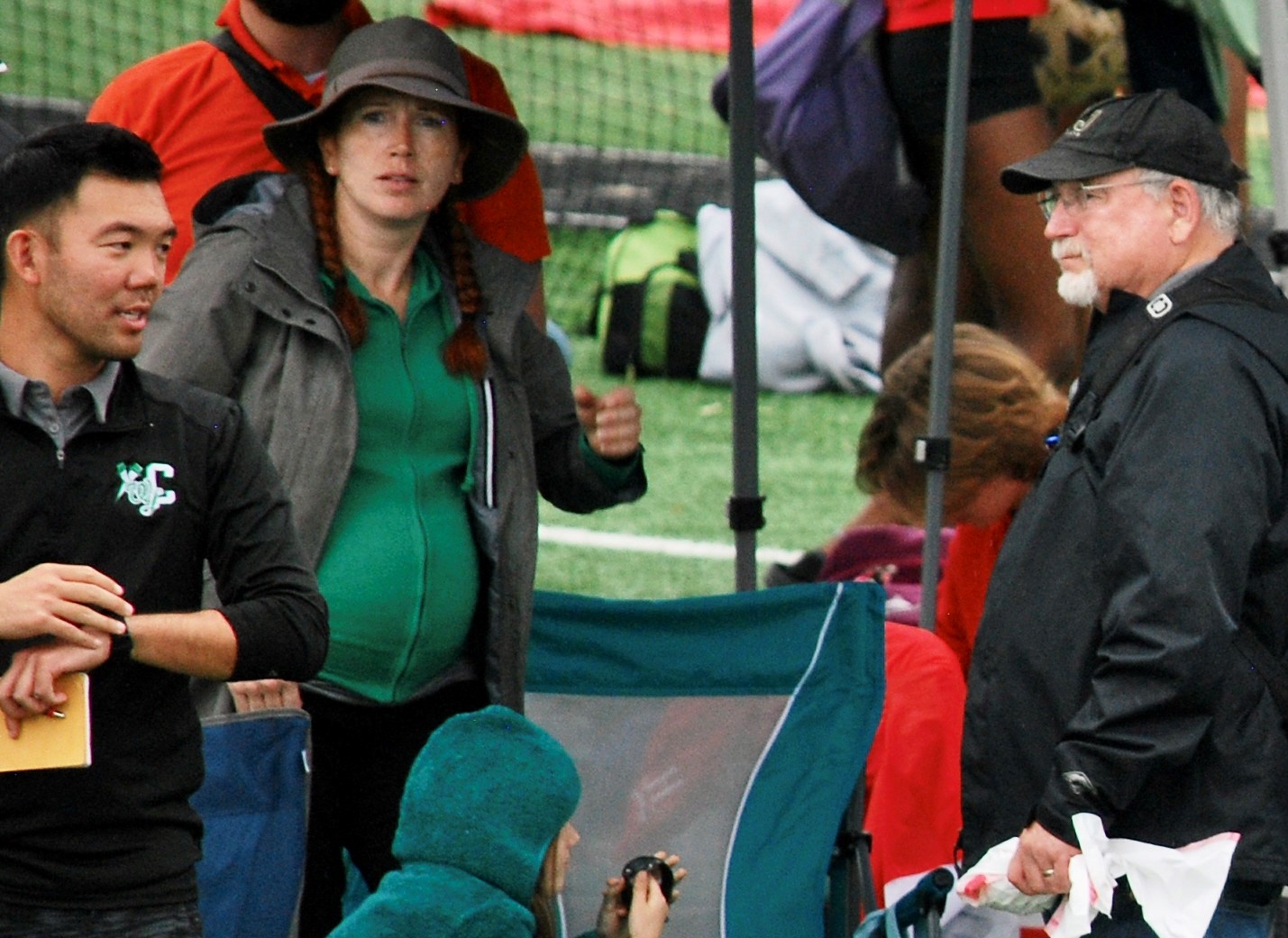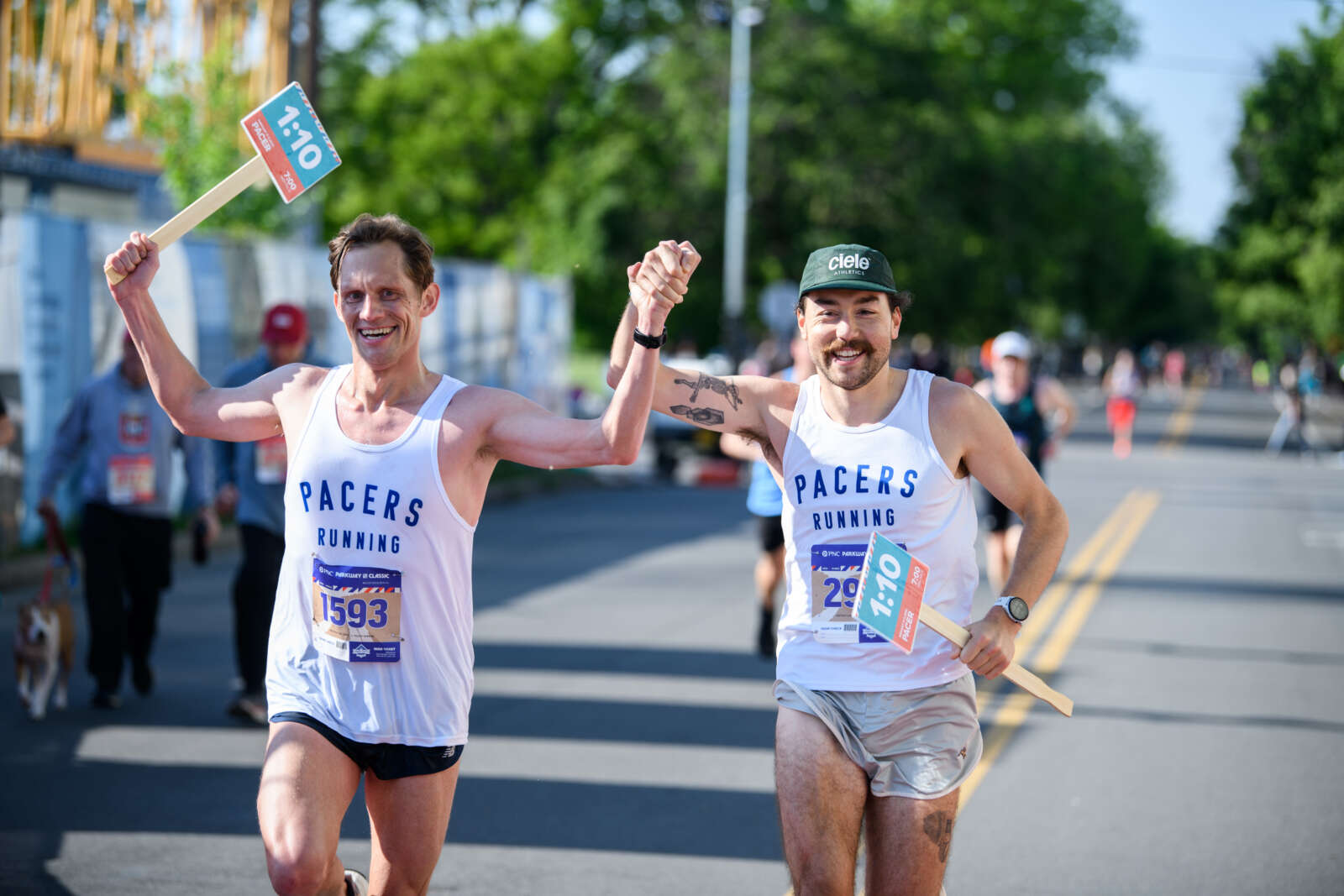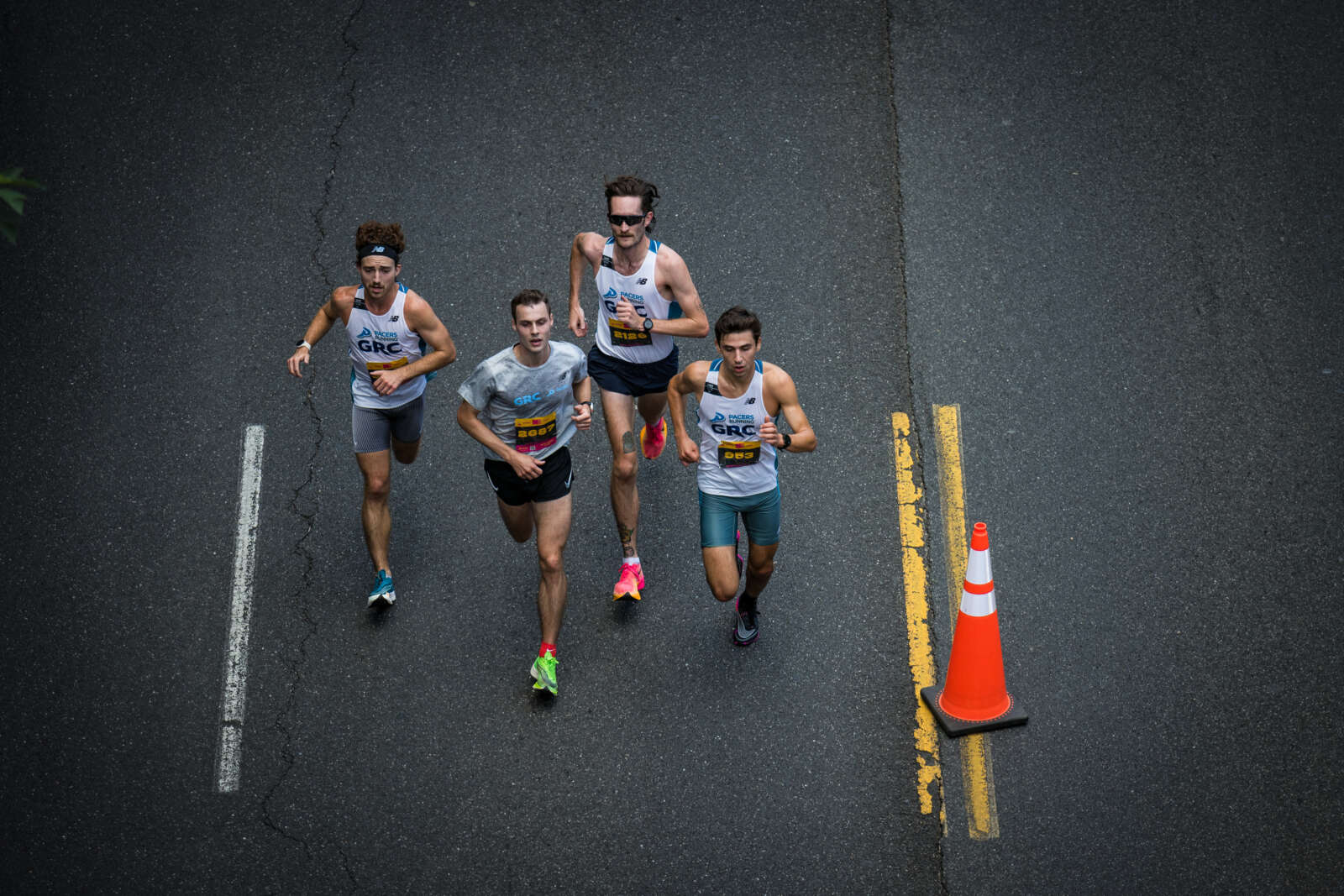Finishing the For the Love of It 10K was special for Reston’s Kate Hutton. After having her first child eight months ago, she has taken her return to running slowly and cautiously, essentially re-starting her running career from scratch. She was finally capable of running more than six miles.
For her, pregnancy threw her fine-tuned body out of whack, far from the easy pregnancies she had heard about, and her initial goal of running as long as she could. And she’s not alone.
Hutton’s baby developed quickly and grew larger than average at over nine pounds. Due to the increased stress on her body and concern for herself and the baby, Hutton stopped her running at the end of the first trimester.
But although she no longer ran, that did not mean she cut cardio entirely. As an alternative, Hutton switched to the elliptical and did many of her workouts on the machine instead.
Running with a stroller
“I stayed really active all the way until the end. Even the week before I had my baby, I walked a mile a day, though that mile took 40 minutes to walk,” she said.
“A woman’s body changes in nine months more than a man’s body will change in a lifetime and it happens in such an incredibly short amount of time,” said Jennifer Lungren, owner of the Arlington/Alexandria branch of Fit4Mom, a fitness group geared specifically for mothers. The business has multiple branches in the D.C. area.
Jaclyn Robertson, owner of Falls Church’s Fit4Mom, notes that it is important for pregnant women to work out, but to do so “within the ramifications of a growing person in your body.” One of the best ways to do that, she said, is to work on balance.
But running or working out postpartum is where the real trouble comes. Right after pregnancy, mothers are not advised to run at all, with a typical 6-8-week waiting period. But even after that time has passed, that does not mean the mothers are able to jump back into it easily.
“[The mother] is sleep deprived and hungry and nursing. So what we try to encourage women to do is say, ‘It took you nine months to grow the baby. It’s going to take you nine months to go back to a sort of normal,'” Robertson said. “You need to take the time to recover your body and for runners in particular, you can’t go back to running four weeks postpartum and you can’t really run with a baby in a stroller when they’re that little.”
Alexandria’s Marissa Shipe trains with both the Springfield and Alexandria chapters of Moms RUN This Town.
After having had two kids in the last two years, Shipe is well aware of the adaptations she needed to train during pre- and postnatal stages, starting with finding a way to run with her infant before she was old enough to be in the running stroller.
“Technically, babies can’t be in the stroller until they are three months old, so I ran with her in her regular stroller in the car seat until she was old enough to go in the running stroller,” Shipe said.
Even when she was able to run with a proper running stroller, things did not get easier right away, especially given the hills in her Alexandria neighborhood.
“Most people in MRTT avoid my neighborhood because it is so hilly,” she said.
As a result, Shipe found herself working extra hard to push the stroller up and down the numerous hills.
Capitol Hill resident Michelle Cain, owner of D.C.’s Fit4Mom franchise, said there’s a misconception that women can jump right back into it.
“A lot of moms say, ‘I got my doctor’s clearance. I should be able to jump right back,’ and that’s not the case. I think one of the hardest challenges I see for women is taking it slow and easing it back in.”
Hutton agrees. “[I] was cleared at six weeks to go back to light exercise, which was really surprising to me. I kind of laughed at my doctor. I said, ‘Are you sure?'”
“[I] read online recommendations that six weeks is too early. We should really be recommending 12 weeks postpartum, so I was trying to be super conservative,” Hutton said.
With so much different information out there, when is that time when women can return to their regular workouts? The answer: It depends.
“It’s different for everyone,” Cain said. “There is a lot of talk lately about, ‘When is the right time to start working out after pregnancy?’ In the past, we have recommended generally within the six to eight weeks mark, but now women are getting cleared earlier than that. But it really depends on the women.”
According to Cain, factors for being cleared to run include: “Were they fit and active before the pregnancy? How complicated was the pregnancy? Or, how was the recovery?”
Sometimes these issues can take a while to overcome. For example, Cain, who has a 17-month old now, is still dealing with IT-band and core issues.
“If you do it the right way for your body, meaning coming back at the pace and intensity level that works for you, you can come back and let your body heal and strengthen. If you do core breathing and start with some strength training, that’s a really great way to help your body as it moves along in the post-partum journey,” she said.
That slow easing back in is important. In many cases, women may have to completely relearn how to run again after their body has fundamentally changed. The most common changes in a woman’s body are expanded rib cages, expanded hips, a new breast size, changes in breast elasticity, swollen hands and feet, and fallen arches. For some, these changes can be so dramatic that it is as if they are running in a new body.
“When I think of women coming back to running [after pregnancy], I’m a little more cognizant of how their body has changed because I need to help them with their form when they’re running. Their hips and bodies have changed or their breasts can be bigger so they need reminders to stand up tall or pull their abs in,” said Nicole LeGesse, Lungren’s colleague with the Arlington/Alexandria branch of Fit4Mom.
Lungren adds that she often sees women’s gaits change after pregnancy due to the spreading of her hips or rib cages. “[I’ll say], ‘Go get your gait analyzed again because you might need new shoes and not just a bigger size.’ … We work with running stores and they check the gait on women and say, ‘Oh my gosh, you need different shoes.'”
To get back to running after her pregnancy, Hutton started first by walking. She started simply walking for three minutes at a time, which in itself was a challenge. After her first three-minute walk she said, “I felt like Rocky when I was done.”
From there, Hutton increased her walks by one minute each day. “I wanted to be slow and intentional about it,” she said.
“My first run back was run walking. [I] ran one minute, walked five minutes – and running was more like a shuffle. It felt so weird for me. It felt like all these muscles were just gone.” It wasn’t until the end of September that Hutton was able to run a full mile without stopping.
After running her first non-stop mile, she felt motivated to sign up for the Reston Turkey Day 5K with the goal of running the entire race without stopping, which she did.
Cain adds that one of the most common issues she sees for women coming back into running is a lack of focus on upper-body work, which is particularly important for postpartum mothers. “A lot of moms might feel great at six weeks and then a year down the line, they’re having back pain and they’re hunched over. Something we talk about is strengthening the core and the upper body. A lot of women don’t work out the upper body. They are more cardio-focused.”
Hutton has noticed the need for core strength on her own. “The weirdest thing for me is I am so much more aware of my core strength than I was before and I am really conscious, especially in my lower abdominal area, that I am engaging my core when I run.”
In some cases, some bodily changes are temporary or can be mitigated with training. “Many moms are just working to contract their cores again who need to do basic core exercises. Some moms have incontinence issues and are just trying to jump without peeing,” Cain said.
“We talk about internal health like pelvic core health. We specially train our moms with that in mind because we want them to heal from the inside all the way out,” Lungren said.
Shipe also cites the need to drink more water for breast-feeding mothers. “As a breast-feeding runner, you have to make sure that your water intake is pretty extraordinary to maintain running and breastfeeding, which is not my strength,” Shipe said. “I’m not great at drinking water, but it’s something I have to be very mindful of.”
But for the many bodily changes that are permanent, coping with the changes can sometimes be difficult to accept.
“We need to give ourselves space and forgiveness. We’re all in different bodies. It is a completely different body and she may never be that same body that she had 12 months ago and that’s just the reality of it. We need to give ourselves more permission to accept that we are going to move differently,” Lungren said.
In addition to the physical changes that can come from childbirth, sleep deprivation and postpartum depression are common problems that new mothers face.
“Women are surprised when they have their babies, how isolating motherhood is,” Robertson said.
Reflecting on her own experiences, Robinson knows firsthand how exercise can help with issues like postpartum depression. “If exercise is what it takes to get me out of the house and talk to someone other than my infant, I’m going to do it. That’s what kept me going, not the workout.”
Exercise can even help with sleep deprivation, Cain said. “Fitness can help with endorphins that can counteract the sleep deprivation that comes from postpartum experiences.”
Despite all of the complications associated with pre- and postpartum running, it is certainly not the end. Most women can return to their regular fitness levels. In some cases, Lungren said that women find that after pregnancy, they even move better and stronger than they have at other times in their lives.
Shipe can attest to that fact firsthand. To Shipe’s surprise, running with the added weight of the stroller has improved her overall strength, leading her to run some of the best times yet.
“Running with a stroller has made me faster than I’ve ever run in my life and I was a college runner, so I’m pretty fast. I’ve had the most PRs in my life since I started running with the stroller,” she said. Those PRs include times in the 5k, 10k, 10-mile, and 13.1-mile distances, all achieved while training with the stroller.
Shipe said there is no doubt in her mind that the stroller is the reason for her improvement. “I don’t do any sort of speed training. I run with the stroller and run up and down the hills and it’s the only thing I’ve done differently, so I absolutely think it has to do with the [extra] weight.”
“You have a 22-pound stroller plus a child and at her lightest, she’s probably about 12 pounds, maybe 10, and now she weighs 27 pounds, so when I’m running without that, it’s like I’m flying. So I absolutely attribute that to [the stroller].”
Shipe said the true moment where she realized how far she had come was during this past September when she won an alumni race against members of her former track team. Shipe was the only mother among the runners. “I think [winning that race] absolutely had to do with being a mom and everything you’re faced with in running and managing your kids and your house. Both time management and pushing the stroller makes you physically tougher and mentally tougher … It was a pretty good feeling being the only one that had children. At the time that I ran, I was seven months postpartum. And I beat everyone that I used to run with, which was incredibly empowering.”
While the physical changes of motherhood made her stronger and faster, Shipe said that running has, in turn, also made her a better mother.
“When I had my first daughter, I struggled with postpartum depression pretty significantly and I wasn’t really able to get back to myself until I was able to run again and as soon as I got back to running, I was happier and I was a better mom and I was able to stop the antidepressant that I was on,” she said.
Cain agrees. For her, the entire perception of fitness changed for her after having kids. “Before I had kids, I’d [say] that fitness is important to keep you healthy. But now I see the true why of what fitness can do for people for both mental and physical [reasons].”
Recent Stories
Looking for our race calendar? Click here Submit races here or shop local for running gear
Zebra Dazzle 5k Walk/Run or 100 Bike over 30 Days
Join the Zebras for this Zebra Dazzle event for all fitness levels. The 5k Walk/Run has 2 options. You can participate as an onsite participant on 9/13 at Carter Barron in Rock Creek Park, NW Washington DC or as a
Hero Dogs 5K9
Hero Dogs Inc will host its 5th Annual 5K9 race at the Congressional Cemetery on Saturday, May 17th, beginning at 8 am. There will also be a 1K Fun Run. The 1K Fun Run will start at 8 am sharp






